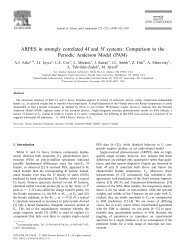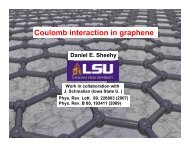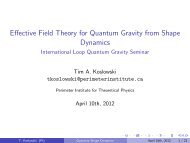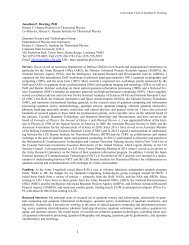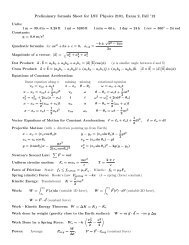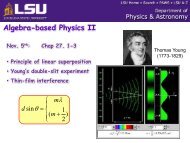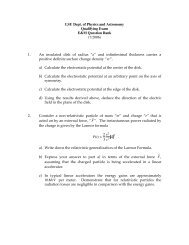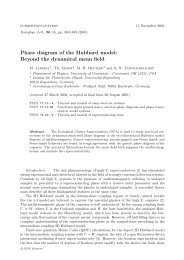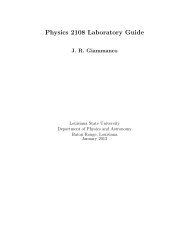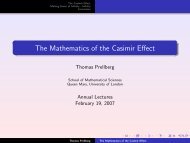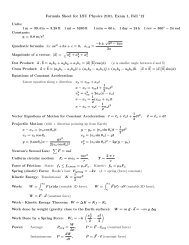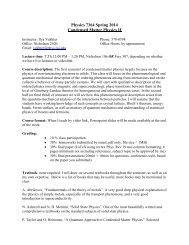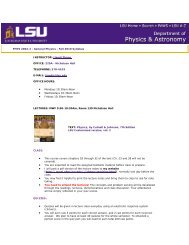Hierarchy of Self-Consistent Approximate Methods and the Parquet ...
Hierarchy of Self-Consistent Approximate Methods and the Parquet ...
Hierarchy of Self-Consistent Approximate Methods and the Parquet ...
Create successful ePaper yourself
Turn your PDF publications into a flip-book with our unique Google optimized e-Paper software.
<strong>Hierarchy</strong> <strong>of</strong> <strong>Self</strong>-<strong>Consistent</strong> <strong>Approximate</strong> <strong>Methods</strong> <strong>and</strong> <strong>the</strong><br />
<strong>Parquet</strong> Formalism<br />
Shuxiang Yang<br />
April 29, 2011<br />
1
Motivation<br />
<strong>Parquet</strong> formalism<br />
• Vertex<br />
• Scattering channels<br />
• Reducibility<br />
• Equations<br />
Outline<br />
<strong>Hierarchy</strong> <strong>of</strong> self-consistent approximate methods<br />
• Hartree-Fock approximation F = 0<br />
• Second-Order perturbation <strong>the</strong>ory (SOPT)<br />
F = U<br />
• R<strong>and</strong>om Phase approximation (RPA), T-matrix approximation <strong>and</strong> Fluctuation Exchange<br />
(FLEX) approximation Γ = U<br />
• <strong>Parquet</strong> approximation (PA)<br />
Λ = U<br />
• Multi-Scale Many-Body (MSMB) approach<br />
Λ II = Λ I,QMC<br />
Numerical results for a toy model <strong>and</strong> Hubbard model<br />
Conclusion<br />
<strong>Hierarchy</strong> <strong>of</strong> <strong>Self</strong>-<strong>Consistent</strong> <strong>Approximate</strong> <strong>Methods</strong> <strong>and</strong> <strong>the</strong> <strong>Parquet</strong> Formalism 2
Motivation<br />
For <strong>the</strong> strongly-correlated electron systems, <strong>the</strong> Hubbard model is a minimum<br />
model<br />
H = −t ∑ 〈i,j〉,σ (c† i,σ c j,σ + h.c.) + U ∑ i n i,↑n i,↓<br />
<strong>Hierarchy</strong> <strong>of</strong> <strong>Self</strong>-<strong>Consistent</strong> <strong>Approximate</strong> <strong>Methods</strong> <strong>and</strong> <strong>the</strong> <strong>Parquet</strong> Formalism 3
Motivation<br />
For <strong>the</strong> strongly-correlated electron systems, <strong>the</strong> Hubbard model is a minimum<br />
model<br />
H = −t ∑ 〈i,j〉,σ (c† i,σ c j,σ + h.c.) + U ∑ i n i,↑n i,↓<br />
Diagrammatic method is a popular approach to analyze this model<br />
Central question:<br />
How to sum up as many as possible physically relevant Feynman diagrams<br />
=⇒ <strong>Self</strong>-consistent diagrammatic approximate methods<br />
<strong>Hierarchy</strong> <strong>of</strong> <strong>Self</strong>-<strong>Consistent</strong> <strong>Approximate</strong> <strong>Methods</strong> <strong>and</strong> <strong>the</strong> <strong>Parquet</strong> Formalism 4
Green function <strong>and</strong> self-energy<br />
(x 2 , t 2 )<br />
(x 1 , t 1 )<br />
• 1-particle Green function G<br />
ψ(x 2 , t 2 ) = ∫ G(x 2 , t 2 ; x 1 , t 1 )ψ(x 1 , t 1 ) dx 1 dt 1<br />
⊲ amplitude (phase) accumulated when a particle moving around some path<br />
⊲ long-ranged<br />
• self-energy Σ<br />
⊲ renormalization due to <strong>the</strong> interaction with o<strong>the</strong>r particles<br />
⊲ short-ranged<br />
• Similarly, we can define 2-partilce Green function <strong>and</strong> 2-particle “self-energy” (vertex).<br />
<strong>Hierarchy</strong> <strong>of</strong> <strong>Self</strong>-<strong>Consistent</strong> <strong>Approximate</strong> <strong>Methods</strong> <strong>and</strong> <strong>the</strong> <strong>Parquet</strong> Formalism 5
<strong>Self</strong>-<strong>Consistent</strong> Diagrammatic Calculation<br />
• Conventional perturbation calculation (Green function G based)<br />
⊲ G = G[G 0 , U], e.g., 1st-order (Hartree)<br />
• Conventional perturbation calculation (self-energy Σ based)<br />
⊲ Σ = Σ[G 0 , U]<br />
⊲ G = G 0<br />
1−ΣG 0<br />
• <strong>Self</strong>-<strong>Consistent</strong> Diagrammatic Calculation<br />
⊲ Σ = Σ[G, U, F ]<br />
⊲ G = G 0<br />
+ + +<br />
G<br />
Σ =<br />
1−ΣG 0<br />
Σ<br />
1st iter<br />
+ +<br />
+<br />
2nd iter<br />
+ + +<br />
<strong>Hierarchy</strong> <strong>of</strong> <strong>Self</strong>-<strong>Consistent</strong> <strong>Approximate</strong> <strong>Methods</strong> <strong>and</strong> <strong>the</strong> <strong>Parquet</strong> Formalism 6
Schwinger-Dyson equation<br />
Schwinger-Dyson equation: Σ = Σ[G, U,F ]<br />
• relating Σ to F , a bridge between one-particle <strong>and</strong> two-particle quantities<br />
• exact, derived from <strong>the</strong> Equation <strong>of</strong> Motion<br />
Σ<br />
=<br />
+<br />
F<br />
• Two questions about F :<br />
⊲ What is F – Vertex describing <strong>the</strong> 2-particle scattering process.<br />
⊲ How to determine F — Using parquet formalism.<br />
<strong>Hierarchy</strong> <strong>of</strong> <strong>Self</strong>-<strong>Consistent</strong> <strong>Approximate</strong> <strong>Methods</strong> <strong>and</strong> <strong>the</strong> <strong>Parquet</strong> Formalism 7
Vertex<br />
v<br />
<strong>Hierarchy</strong> <strong>of</strong> <strong>Self</strong>-<strong>Consistent</strong> <strong>Approximate</strong> <strong>Methods</strong> <strong>and</strong> <strong>the</strong> <strong>Parquet</strong> Formalism 8
Vertex<br />
v<br />
+<br />
initial<br />
3 1<br />
+ + 4<br />
H<br />
2<br />
P<br />
F ph<br />
h<br />
final<br />
|3, 4 >→ |1, 2 ><br />
<strong>Hierarchy</strong> <strong>of</strong> <strong>Self</strong>-<strong>Consistent</strong> <strong>Approximate</strong> <strong>Methods</strong> <strong>and</strong> <strong>the</strong> <strong>Parquet</strong> Formalism 9
Vertex<br />
3<br />
P<br />
1<br />
4<br />
initial<br />
F ph<br />
h<br />
H<br />
final<br />
2<br />
|3, 4 >→ |1, 2 ><br />
• vertex: matrix used to describe scattering process<br />
• F ph<br />
h<br />
(12; 34): <strong>the</strong> amplitude <strong>of</strong> a particle-hole pair scattered from its initial state |3, 4 > to<br />
<strong>the</strong> final state |1, 2 >.<br />
• i ≡ P i ≡ (k i , iω ni ), or i ≡ (P i , σ i , m i ) if <strong>the</strong> internal degrees <strong>of</strong> freedom are included, say<br />
<strong>the</strong> spin σ i or b<strong>and</strong> index m i .<br />
<strong>Hierarchy</strong> <strong>of</strong> <strong>Self</strong>-<strong>Consistent</strong> <strong>Approximate</strong> <strong>Methods</strong> <strong>and</strong> <strong>the</strong> <strong>Parquet</strong> Formalism 10
scattering channels<br />
p-h horizontal channel<br />
3<br />
P<br />
1<br />
4<br />
initial<br />
F ph<br />
h<br />
H<br />
final<br />
2<br />
|3, 4 >→ |1, 2 ><br />
3 1<br />
P<br />
4<br />
F ph v<br />
H<br />
2<br />
|3, 1 >→ |4, 2 ><br />
p-h vertical channel<br />
initial<br />
final<br />
3<br />
P<br />
1<br />
4<br />
F pp<br />
P<br />
p-p channel<br />
2<br />
<strong>Hierarchy</strong> <strong>of</strong> <strong>Self</strong>-<strong>Consistent</strong> <strong>Approximate</strong> <strong>Methods</strong> <strong>and</strong> <strong>the</strong> <strong>Parquet</strong> Formalism 11
scattering channels<br />
p-h horizontal channel<br />
3<br />
P<br />
1<br />
4<br />
initial<br />
F ph<br />
h<br />
H<br />
final<br />
2<br />
|3, 4 >→ |1, 2 ><br />
analogous to <strong>the</strong> way to<br />
arrange small pieces <strong>of</strong> parquet<br />
3 1<br />
P<br />
4<br />
F ph v<br />
H<br />
2<br />
|3, 1 >→ |4, 2 ><br />
p-h vertical channel<br />
initial<br />
final<br />
3<br />
P<br />
1<br />
4<br />
F pp<br />
P<br />
p-p channel<br />
2<br />
<strong>Hierarchy</strong> <strong>of</strong> <strong>Self</strong>-<strong>Consistent</strong> <strong>Approximate</strong> <strong>Methods</strong> <strong>and</strong> <strong>the</strong> <strong>Parquet</strong> Formalism 12
1-particle reducibility<br />
reducible<br />
+<br />
⇒T<br />
irreducible<br />
+<br />
⇒<br />
Σ<br />
cutting one line !<br />
One-particle formalism<br />
1-particle<br />
re<br />
irre<br />
G T Σ<br />
Dyson equations<br />
G = G 0 + G 0 ∗ T ∗ G 0<br />
G = G 0 + G 0 ∗ Σ ∗ G<br />
<strong>Hierarchy</strong> <strong>of</strong> <strong>Self</strong>-<strong>Consistent</strong> <strong>Approximate</strong> <strong>Methods</strong> <strong>and</strong> <strong>the</strong> <strong>Parquet</strong> Formalism 13
2-particle reducibility<br />
reducible<br />
+<br />
cutting two lines !<br />
<strong>Hierarchy</strong> <strong>of</strong> <strong>Self</strong>-<strong>Consistent</strong> <strong>Approximate</strong> <strong>Methods</strong> <strong>and</strong> <strong>the</strong> <strong>Parquet</strong> Formalism 14
2-particle reducibility<br />
reducible<br />
+<br />
irreducible<br />
+<br />
+<br />
<strong>Hierarchy</strong> <strong>of</strong> <strong>Self</strong>-<strong>Consistent</strong> <strong>Approximate</strong> <strong>Methods</strong> <strong>and</strong> <strong>the</strong> <strong>Parquet</strong> Formalism 15
2-particle reducibility<br />
reducible<br />
+<br />
irreducible<br />
+<br />
+<br />
<strong>Hierarchy</strong> <strong>of</strong> <strong>Self</strong>-<strong>Consistent</strong> <strong>Approximate</strong> <strong>Methods</strong> <strong>and</strong> <strong>the</strong> <strong>Parquet</strong> Formalism 16
2-particle reducibility<br />
reducible<br />
+<br />
irreducible<br />
+<br />
+<br />
fully irreducible<br />
+<br />
+<br />
<strong>Hierarchy</strong> <strong>of</strong> <strong>Self</strong>-<strong>Consistent</strong> <strong>Approximate</strong> <strong>Methods</strong> <strong>and</strong> <strong>the</strong> <strong>Parquet</strong> Formalism 17
2-particle reducibility<br />
reducible<br />
+<br />
irreducible<br />
+<br />
+<br />
⇒<br />
⇒<br />
F<br />
Γ<br />
fully irreducible<br />
+<br />
v<br />
+<br />
⇒<br />
Λ<br />
<strong>Hierarchy</strong> <strong>of</strong> <strong>Self</strong>-<strong>Consistent</strong> <strong>Approximate</strong> <strong>Methods</strong> <strong>and</strong> <strong>the</strong> <strong>Parquet</strong> Formalism 18
2-particle reducibility<br />
reducible<br />
+<br />
irreducible<br />
+<br />
+<br />
⇒<br />
⇒<br />
F<br />
Γ<br />
fully irreducible<br />
+<br />
v<br />
+<br />
⇒<br />
Λ<br />
How are F , Γ <strong>and</strong> Λ related –> Be<strong>the</strong>-Salpeter equation <strong>and</strong> <strong>Parquet</strong> equation.<br />
<strong>Hierarchy</strong> <strong>of</strong> <strong>Self</strong>-<strong>Consistent</strong> <strong>Approximate</strong> <strong>Methods</strong> <strong>and</strong> <strong>the</strong> <strong>Parquet</strong> Formalism 19
Be<strong>the</strong>-Salpeter equation <strong>and</strong> <strong>Parquet</strong> equation<br />
• Be<strong>the</strong>-Salpeter equation<br />
⊲ describing how a reducible vertex is decomposed in its own scattering channel<br />
⊲ exact, derived from <strong>the</strong> categorization <strong>of</strong> <strong>the</strong> Feynman diagrams<br />
F<br />
= Γ + Γ F<br />
• <strong>Parquet</strong> equation<br />
⊲ describing how a irreducible vertex is still decomposable in <strong>the</strong> o<strong>the</strong>r two scattering<br />
channels<br />
⊲ exact, derived from <strong>the</strong> categorization <strong>of</strong> <strong>the</strong> Feynman diagrams<br />
Γ<br />
Γ v<br />
= Λ + + Γ p F p<br />
F v<br />
<strong>Hierarchy</strong> <strong>of</strong> <strong>Self</strong>-<strong>Consistent</strong> <strong>Approximate</strong> <strong>Methods</strong> <strong>and</strong> <strong>the</strong> <strong>Parquet</strong> Formalism 20
Be<strong>the</strong>-Salpeter equation <strong>and</strong> <strong>Parquet</strong> equation<br />
• Be<strong>the</strong>-Salpeter equation<br />
⊲ describing how a reducible vertex is decomposed in its own scattering channel<br />
⊲ exact, derived from <strong>the</strong> categorization <strong>of</strong> <strong>the</strong> Feynman diagrams<br />
F<br />
= Γ + Γ F<br />
• <strong>Parquet</strong> equation<br />
⊲ describing how a irreducible vertex is still decomposable in <strong>the</strong> o<strong>the</strong>r two scattering<br />
channels<br />
⊲ exact, derived from <strong>the</strong> categorization <strong>of</strong> <strong>the</strong> Feynman diagrams<br />
Γ<br />
Γ v<br />
= Λ + + Γ p F p<br />
F v<br />
<strong>Hierarchy</strong> <strong>of</strong> <strong>Self</strong>-<strong>Consistent</strong> <strong>Approximate</strong> <strong>Methods</strong> <strong>and</strong> <strong>the</strong> <strong>Parquet</strong> Formalism 21
<strong>Parquet</strong> formalism<br />
1-particle<br />
2-particle<br />
re irre fully irre<br />
G T Σ<br />
S.D.<br />
χ F Γ Λ<br />
B.S.<br />
more localized<br />
<strong>Parquet</strong><br />
Be<strong>the</strong>-Salpeter equation <strong>and</strong> <strong>Parquet</strong> equation<br />
• relating F , Γ <strong>and</strong> Λ<br />
2-particle Dyson equations (recall Dyson e.q. for 1-particle formalism)<br />
• χ = χ 0 + χ 0 ∗ F ∗ χ 0<br />
• χ = χ 0 + χ 0 ∗ Γ ∗ χ<br />
<strong>Hierarchy</strong> <strong>of</strong> <strong>Self</strong>-<strong>Consistent</strong> <strong>Approximate</strong> <strong>Methods</strong> <strong>and</strong> <strong>the</strong> <strong>Parquet</strong> Formalism 22
<strong>Hierarchy</strong> <strong>of</strong> self-consistent approximate methods<br />
1-particle<br />
2-particle<br />
F = 0<br />
G T Σ<br />
S.D.<br />
χ F Γ Λ<br />
H-F<br />
re irre fully irre<br />
B.S.<br />
more localized<br />
<strong>Parquet</strong><br />
Better approximation<br />
<strong>Hierarchy</strong> <strong>of</strong> <strong>Self</strong>-<strong>Consistent</strong> <strong>Approximate</strong> <strong>Methods</strong> <strong>and</strong> <strong>the</strong> <strong>Parquet</strong> Formalism 23
Hartree-Fock approximation: F = 0<br />
• No vertex correction to <strong>the</strong> self-energy<br />
• 〈n i↑ n i↓ 〉 = 〈n i↑ 〉〈n i↓ 〉 (χ = G ∗ G)<br />
• Lowest-order correction: O(U 2 )<br />
Σ<br />
=<br />
<strong>Hierarchy</strong> <strong>of</strong> <strong>Self</strong>-<strong>Consistent</strong> <strong>Approximate</strong> <strong>Methods</strong> <strong>and</strong> <strong>the</strong> <strong>Parquet</strong> Formalism 24
<strong>Hierarchy</strong> <strong>of</strong> self-consistent approximate methods<br />
1-particle<br />
2-particle<br />
F = 0<br />
F ≈ v<br />
G T Σ<br />
S.D.<br />
χ F Γ Λ<br />
H-F<br />
SOPT<br />
re irre fully irre<br />
B.S.<br />
more localized<br />
<strong>Parquet</strong><br />
Better approximation<br />
<strong>Hierarchy</strong> <strong>of</strong> <strong>Self</strong>-<strong>Consistent</strong> <strong>Approximate</strong> <strong>Methods</strong> <strong>and</strong> <strong>the</strong> <strong>Parquet</strong> Formalism 25
<strong>Self</strong>-consistent Second-Order Perturbation Theory (SOPT): F ≈ v<br />
• using Schwinger-Dyson equation only<br />
• Lowest-order correction: O(U 3 )<br />
Σ =<br />
+<br />
<strong>Hierarchy</strong> <strong>of</strong> <strong>Self</strong>-<strong>Consistent</strong> <strong>Approximate</strong> <strong>Methods</strong> <strong>and</strong> <strong>the</strong> <strong>Parquet</strong> Formalism 26
<strong>Hierarchy</strong> <strong>of</strong> self-consistent approximate methods<br />
1-particle<br />
2-particle<br />
F = 0<br />
F ≈ v<br />
Γ ≈ v<br />
re irre fully irre<br />
G T Σ<br />
S.D.<br />
χ F Γ Λ<br />
B.S.<br />
more localized<br />
H-F<br />
SOPT<br />
RPA, TMA, FLEX<br />
<strong>Parquet</strong><br />
Better approximation<br />
<strong>Hierarchy</strong> <strong>of</strong> <strong>Self</strong>-<strong>Consistent</strong> <strong>Approximate</strong> <strong>Methods</strong> <strong>and</strong> <strong>the</strong> <strong>Parquet</strong> Formalism 27
RPA, TMA <strong>and</strong> FLEX: Γ ≈ v<br />
• using both Schwinger-Dyson <strong>and</strong> Be<strong>the</strong>-Salpeter equations<br />
• more diagrams are included<br />
⊲ ring-type: R<strong>and</strong>om Phase Approximation (RPA)<br />
⊲ ladder-type: T-matrix approximation (TMA)<br />
⊲ ring-type <strong>and</strong> ladder-type: Fluctuation Exchange approximation (FLEX)<br />
• Lowest-order correction: O(U 3 )<br />
+<br />
+<br />
+<br />
+<br />
+<br />
+<br />
<strong>Hierarchy</strong> <strong>of</strong> <strong>Self</strong>-<strong>Consistent</strong> <strong>Approximate</strong> <strong>Methods</strong> <strong>and</strong> <strong>the</strong> <strong>Parquet</strong> Formalism 28
<strong>Hierarchy</strong> <strong>of</strong> self-consistent approximate methods<br />
1-particle<br />
2-particle<br />
F = 0<br />
F ≈ v<br />
Γ ≈ v<br />
Λ ≈ v<br />
re irre fully irre<br />
G T Σ<br />
S.D.<br />
χ F Γ Λ<br />
B.S.<br />
more localized<br />
<strong>Parquet</strong><br />
H-F<br />
SOPT<br />
RPA, TMA, FLEX<br />
<strong>Parquet</strong> Approximation<br />
Better approximation<br />
<strong>Hierarchy</strong> <strong>of</strong> <strong>Self</strong>-<strong>Consistent</strong> <strong>Approximate</strong> <strong>Methods</strong> <strong>and</strong> <strong>the</strong> <strong>Parquet</strong> Formalism 29
<strong>Parquet</strong> approximation: Λ ≈ v<br />
• using Schwinger-Dyson, Be<strong>the</strong>-Salpeter <strong>and</strong> <strong>Parquet</strong> equations<br />
• more diagrams: ring+ladder-type <strong>and</strong> simply-crossed, are included<br />
• Lowest-order correction: O(U 5 )<br />
+ + +<br />
<strong>Hierarchy</strong> <strong>of</strong> <strong>Self</strong>-<strong>Consistent</strong> <strong>Approximate</strong> <strong>Methods</strong> <strong>and</strong> <strong>the</strong> <strong>Parquet</strong> Formalism 30
<strong>Parquet</strong> approximation: Λ ≈ v<br />
• using Schwinger-Dyson, Be<strong>the</strong>-Salpeter <strong>and</strong> <strong>Parquet</strong> equations<br />
• more diagrams: simply-crossed <strong>and</strong> ring+ladder-type, are included<br />
• Lowest-order correction: O(U 5 )<br />
+ + +<br />
• still some contributions are missing: fully irreducible (complicatedly crossed) → QMC<br />
+<br />
<strong>Hierarchy</strong> <strong>of</strong> <strong>Self</strong>-<strong>Consistent</strong> <strong>Approximate</strong> <strong>Methods</strong> <strong>and</strong> <strong>the</strong> <strong>Parquet</strong> Formalism 31
<strong>Hierarchy</strong> <strong>of</strong> self-consistent approximate methods<br />
1-particle<br />
2-particle<br />
F = 0<br />
F ≈ v<br />
Γ ≈ v<br />
Λ ≈ v<br />
re irre fully irre<br />
G T Σ<br />
S.D.<br />
χ F Γ Λ<br />
B.S.<br />
more localized<br />
<strong>Parquet</strong><br />
H-F<br />
SOPT<br />
RPA, TMA, FLEX<br />
<strong>Parquet</strong> Approximation<br />
Λ II ≈ Λ I,DCA/QMC<br />
Better approximation<br />
DCA/QMC+<strong>Parquet</strong><br />
MSMB<br />
<strong>Hierarchy</strong> <strong>of</strong> <strong>Self</strong>-<strong>Consistent</strong> <strong>Approximate</strong> <strong>Methods</strong> <strong>and</strong> <strong>the</strong> <strong>Parquet</strong> Formalism 32
DCA/QMC + parquet:<br />
Λ II ≈ Λ I,DCA/QMC<br />
• Multi-Scale Many-Body (MSMB) approach: SciDAC project<br />
⊲ short length scales treated explicitly with QMC methods<br />
⊲ intermediate length scales treated diagrammatically using fully irreducible vertices obtained<br />
from QMC<br />
⊲ long length scales treated in <strong>the</strong> mean field.<br />
<strong>Hierarchy</strong> <strong>of</strong> <strong>Self</strong>-<strong>Consistent</strong> <strong>Approximate</strong> <strong>Methods</strong> <strong>and</strong> <strong>the</strong> <strong>Parquet</strong> Formalism 33
summary <strong>of</strong> <strong>the</strong> different approximate methods<br />
G<br />
Σ<br />
⇐ F = 0<br />
HF<br />
G<br />
Σ<br />
⇐ F ≈ v<br />
SOP T<br />
G<br />
⇐ Γ ≈ v<br />
RP A, T MA, F LEX<br />
Σ<br />
F<br />
G<br />
Γ<br />
P A<br />
⇐ Λ ≈ v<br />
MSMB<br />
Λ II ≈ Λ I,DCA/QMC<br />
Σ<br />
F<br />
• iterate until self-consistency is satisfied<br />
• It is also a hierarchy <strong>of</strong> methods with different computational costs<br />
• <strong>the</strong>re are two levels <strong>of</strong> self-consistency for <strong>the</strong> parquet calculation<br />
<strong>Hierarchy</strong> <strong>of</strong> <strong>Self</strong>-<strong>Consistent</strong> <strong>Approximate</strong> <strong>Methods</strong> <strong>and</strong> <strong>the</strong> <strong>Parquet</strong> Formalism 34
application I: toy model<br />
The Hamiltonian for <strong>the</strong> classical anharmonic oscillator is<br />
Its partition function is<br />
H = p2<br />
2m + 1 2 mω2 0x 2 + ux 4 (1)<br />
Z c<br />
= 1 ∫ ∞<br />
Z c,0 Z c,0<br />
−∞<br />
dp<br />
∫ ∞<br />
−∞<br />
dxe −βH =<br />
1<br />
√<br />
2πG<br />
0<br />
∫ ∞<br />
−∞<br />
dψe − ψ2<br />
2G 0 e − g 4! ψ4 (2)<br />
where G 0 = 1/(βmω 2 0), βu = g/4! <strong>and</strong> ψ ≡ x. From this, we can construct <strong>the</strong><br />
conventional perturbation or <strong>the</strong> self-consistent field formalism.<br />
<strong>Hierarchy</strong> <strong>of</strong> <strong>Self</strong>-<strong>Consistent</strong> <strong>Approximate</strong> <strong>Methods</strong> <strong>and</strong> <strong>the</strong> <strong>Parquet</strong> Formalism 35
esult<br />
3<br />
−Σ<br />
2<br />
1<br />
Hartree<br />
2nd-order<br />
self-consistent 2nd-order<br />
FLEX<br />
parquet approximation<br />
exact<br />
0<br />
0 5 10 15 20 25 30<br />
g<br />
• from 2nd-order approximation, FLEX, to parquet approximation, <strong>the</strong> results become better.<br />
<strong>Hierarchy</strong> <strong>of</strong> <strong>Self</strong>-<strong>Consistent</strong> <strong>Approximate</strong> <strong>Methods</strong> <strong>and</strong> <strong>the</strong> <strong>Parquet</strong> Formalism 36
application II: Hubbard model (N c = 1)<br />
Hubbard model: H = −t ∑ 〈i,j〉,σ (c† i,σ c j,σ + h.c.) + U ∑ i n i,↑n i,↓<br />
-0.46<br />
-0.47<br />
Exact<br />
SC 2nd-order<br />
FLEX<br />
PA<br />
G(τ)<br />
-0.48<br />
-0.49<br />
U/T=1.5, Nc=1, Nl=64<br />
-0.5<br />
0 0.2 0.4 0.6 0.8 1<br />
τ/β<br />
<strong>Hierarchy</strong> <strong>of</strong> <strong>Self</strong>-<strong>Consistent</strong> <strong>Approximate</strong> <strong>Methods</strong> <strong>and</strong> <strong>the</strong> <strong>Parquet</strong> Formalism 37
application II: Hubbard model (N c = 4 × 4)<br />
U = 2t, T = 0.3t<br />
S. X. Yang et al., PRE 80, 046706 (2009).<br />
<strong>Hierarchy</strong> <strong>of</strong> <strong>Self</strong>-<strong>Consistent</strong> <strong>Approximate</strong> <strong>Methods</strong> <strong>and</strong> <strong>the</strong> <strong>Parquet</strong> Formalism 38
Conclusion<br />
• <strong>Parquet</strong> formalism<br />
• <strong>Hierarchy</strong> <strong>of</strong> different approximate methods<br />
1-particle<br />
2-particle<br />
F = 0<br />
F ≈ v<br />
Γ ≈ v<br />
Λ ≈ v<br />
re irre fully irre<br />
G T Σ<br />
S.D.<br />
χ F Γ Λ<br />
B.S.<br />
more localized<br />
<strong>Parquet</strong><br />
H-F<br />
SOPT<br />
RPA, TMA, FLEX<br />
<strong>Parquet</strong> Approximation<br />
Λ II ≈ Λ I,DCA/QMC<br />
Better approximation<br />
DCA/QMC+<strong>Parquet</strong><br />
MSMB<br />
<strong>Hierarchy</strong> <strong>of</strong> <strong>Self</strong>-<strong>Consistent</strong> <strong>Approximate</strong> <strong>Methods</strong> <strong>and</strong> <strong>the</strong> <strong>Parquet</strong> Formalism 39



